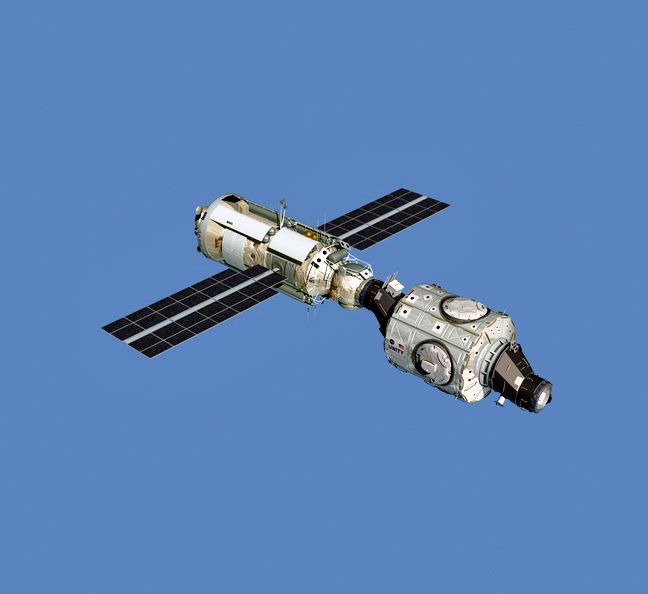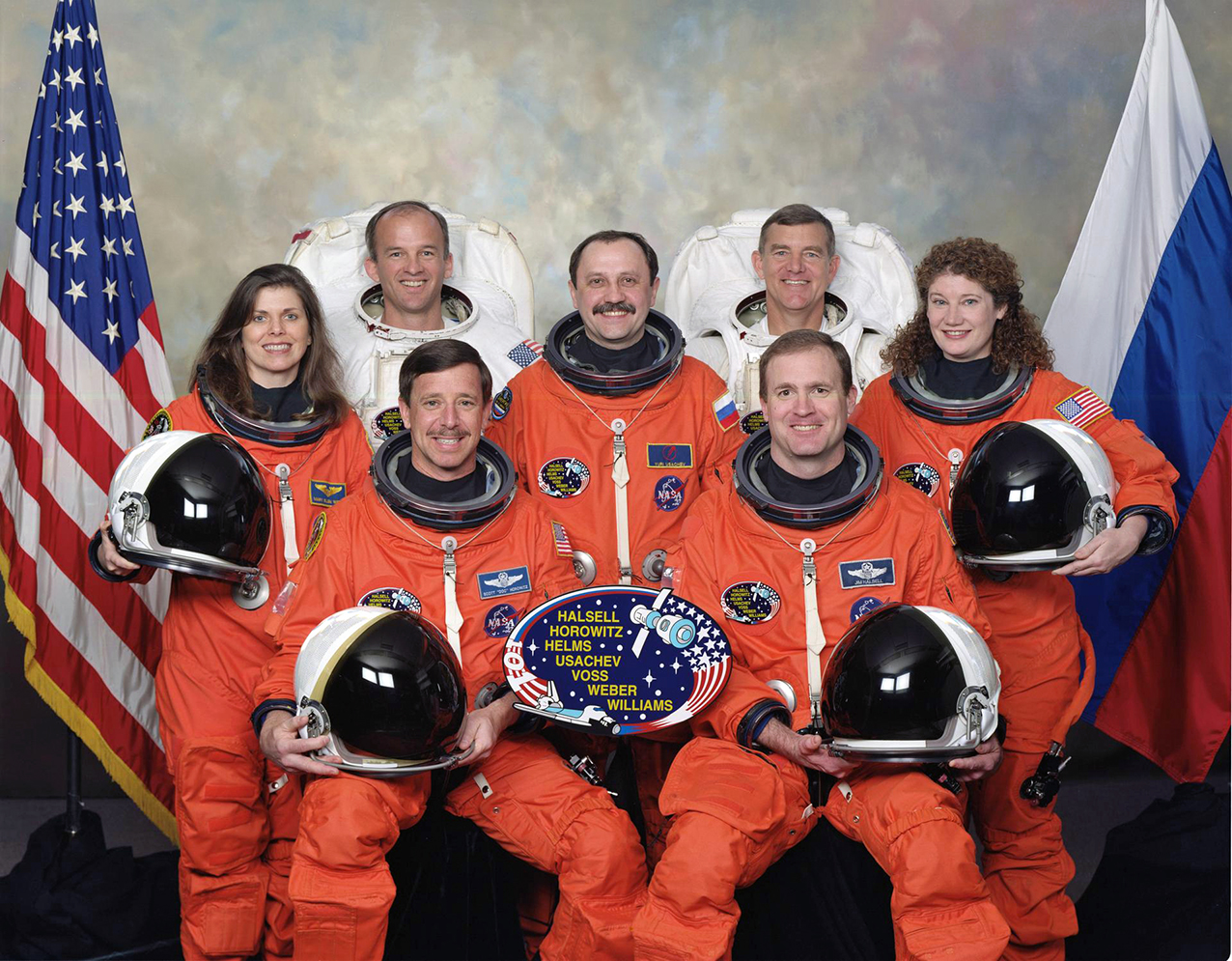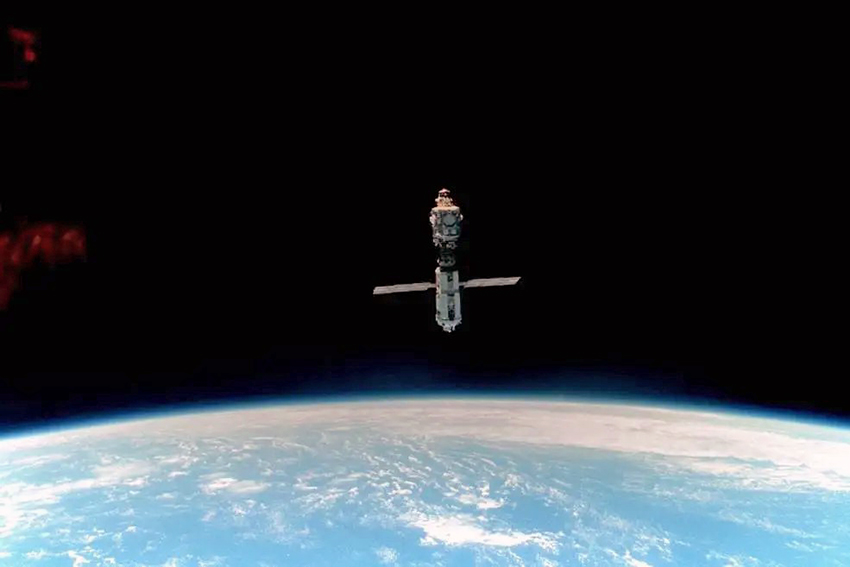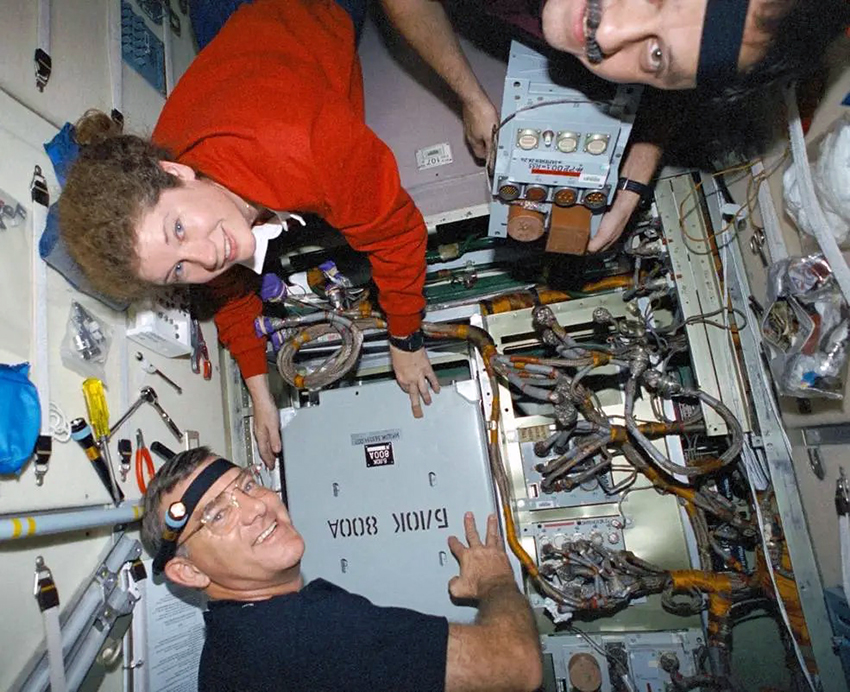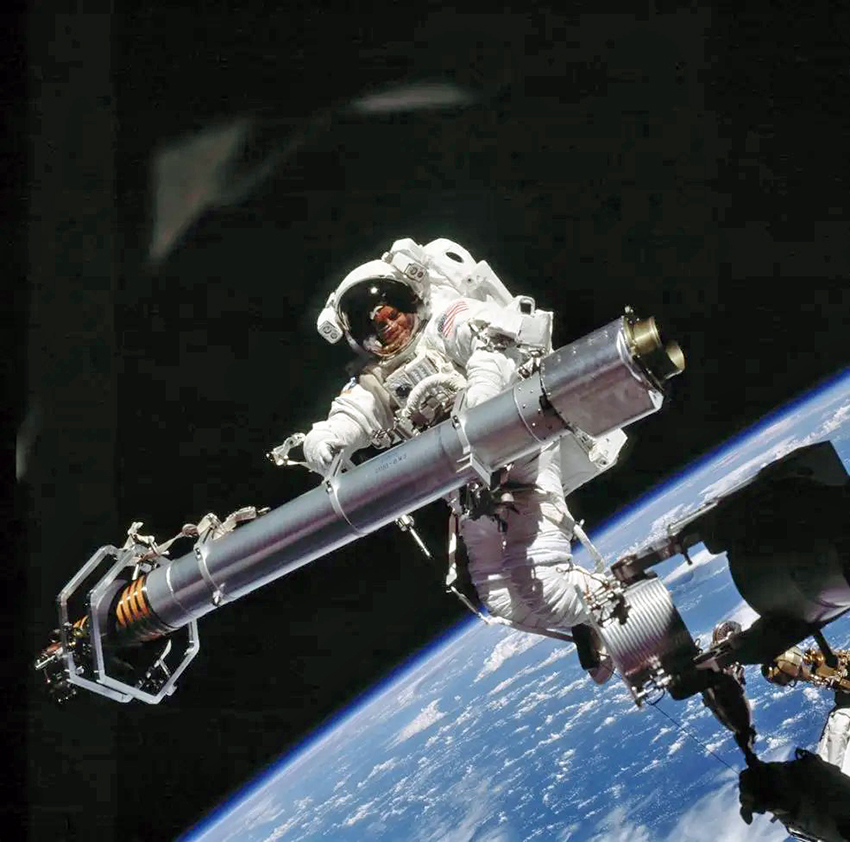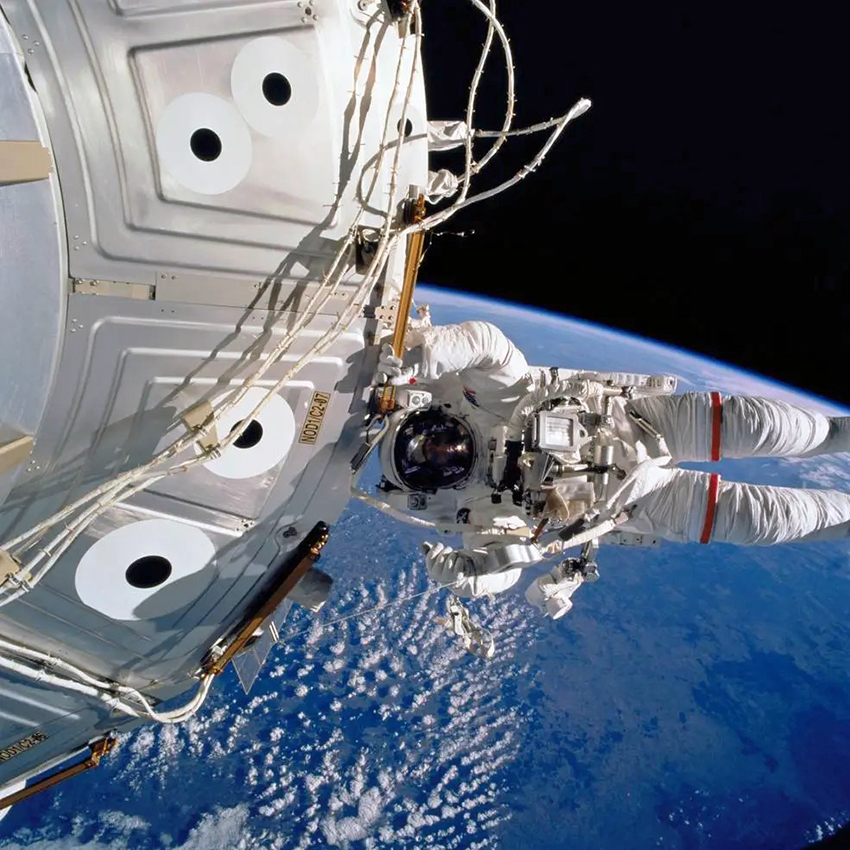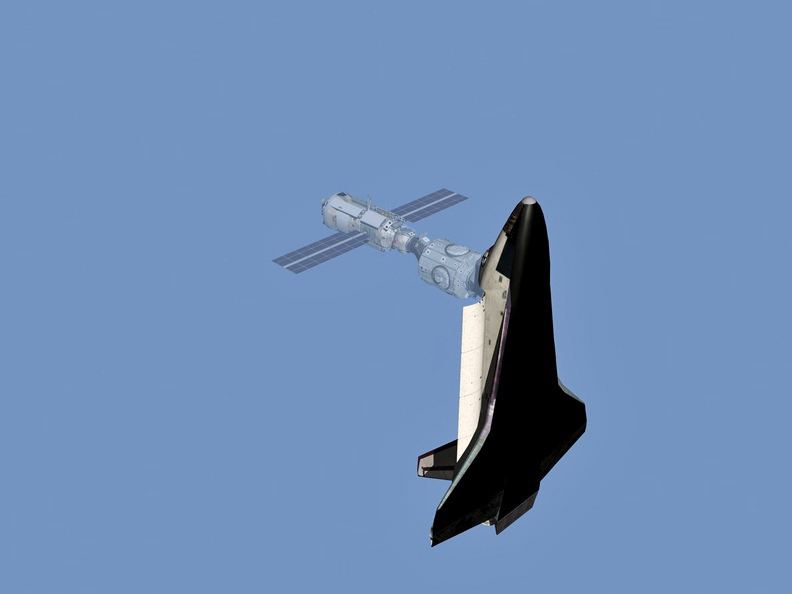Astro Info Service Limited
Information Research Publications Presentations
on the Human Exploration of Space
Established 1982
Incorporation 2003
Company No.4865911
E & OE
Expedition Zero Pt 5
Expedition Zero ISS Operations
Part Five - Still Waiting, Still Troubleshooting
November - December 1999: One Year Logged
During the weekend of 14-15 November, flight controllers in Moscow and Houston began the second round of deep cycling each of the five online batteries inside Zarya. The process was halted when the first battery, Number 2, failed to discharge properly on the second cycle, having earlier completed a full discharge and charge on its first cycle. It was removed from the electrical bus.
The four remaining online batteries could easily handle power requirements on ISS, but non-essential equipment was turned off as a safeguard to conserve power. As the station was following a near full-sunlight orbit as it moved around the Earth, no power or temperature issues were expected to arise and affect the decision. Battery 3 was cycled on 18 November with no problems, but troubleshooting Battery 2 (as well as an overall evaluation and analysis) would be completed before the other three batteries were commanded to cycle.
On 20 November 1999, ISS celebrated its first full year of orbital operations since the launch of Zarya from Baikonur. In its 380 x 364 km (236 x 226 statute mile) orbit, ISS had circled the Earth more than 5,764 times in what had been a difficult first year of flight operations. As the end of the year approached, there was expectant hope that the next 12 months would be more rewarding.
During December, several issues had to be resolved. Firstly, the decision to launch Zvezda was pushed back to late January 2000 at the earliest, as an investigation into the recent failure of the Proton launch vehicle was completed. A General Design Review (GDR) meeting in Moscow would follow in the new year.
On-going problems with the station's battery subsystem led to the decision to bring Battery 1 back online to support operations with Batteries 3-6, while Battery 2 remained disconnected. The recycling of Batteries 4-6 was completed without incident, while Battery 1 also performed normally when reconnected to the system.
On 1 December, two jet thruster firings of Zarya's propulsion units raised the station's orbit to 394 x 383 km (245 x 238 miles), in preparation for the arrival of Zvezda. The first burn occurred at 16:57 Central Standard Time (CST-Houston) and lasted 27 seconds, changing the velocity by 5.4 m/sec (17.7 fps). About 47 minutes later, the second burn (designed to almost circularise the orbit) was initiated at 17:45 and completed after 23 seconds. This burn altered the velocity by a further 4.7 m/sec (15.4 fps).
A test of the Kurs automatic docking system on 8 December revealed some discrepancies in its alternate system's relative docking velocity readings, as seen on the ground. This would necessitate a rerun of the test to determine the cause of the fault. Kurs would be used during the final rendezvous and docking of Zvezda and was critical to the success of the automated docking. A leading candidate for the fault was electromagnetic interference (EMI) from other systems located on the station. The rerun of the test would be conducted in the new year, with power levels reduced to identify whether EMI was indeed the cause. Hardware was not thought to be the problem.
During the latter part of December, controllers uplinked a software 'patch' from Russia's Mission Control to Zarya, enabling 68 additional electrical power system parameters to be sent to the ground via Unity's Early Communication System (ECS) and for more frequent viewing using NASA's Tracking and Data Relay Satellite System (TDRSS) network.
As 1999 closed, the controllers continued routine maintenance and systems checks on the ISS, which was generally healthy apart from a few minor issues. None of these were serious enough to affect station operations.
January 2000: Y2K Comes and Goes
World-wide expectations for major disruptions to computer systems during the rollover from 1999 to 2000 proved wide of the mark. Data received from ISS by flight controllers in Moscow and Houston reported an uneventful computer rollover as year 2000 began.
Recycling of the batteries continued and a good test rerun on the Kurs automated docking system on Zarya was also reported. NASA announced that it was looking at the possibility of flying a new mission in advance of the launch of Zvezda, to be used for maintenance of some of the systems aboard Zarya. Once the Service Module had launched and docked, STS-101 would be launched to prepare the module for the arrival of the first resident crew. This all depended on the outcome of the managers' meeting in Moscow, now planned for February or March, which would determine the launch date for Zvezda.
Early on 16 January, a minor problem occurred during a self-test of one of the two Remote Power Control Module (RPCM) units. These are housed in Unity's connecting module and are designed to route electricity around the Node, with all four RPCMs used only when a Shuttle was docked to Unity.
On 27 January, managers for both the ISS and Shuttle programmes decided to protect the option for sending a Shuttle to the station in April, ahead of Zvezda's arrival which was still under evaluation due to the Proton launcher failure in October. NASA designated 13 April as a target launch date for STS-101, with final confirmation to be given during a planned Joint Program Review (JPR) to be held in February. A target launch date for Zvezda would also be announced at that meeting and, if all went well, a new Shuttle mission would be launched to outfit the Zarya for the first permanent crew.
Prior to the February meeting, an evaluation of processing strategy and crew training issues would be conducted, with one option being to re-fly Atlantis and the STS-101 crew in back-to-back missions. STS-101 Commander Jim Halsell had already experienced this during the STS-94 re-flight of the aborted STS-83 Material Science Laboratory mission in 1998.
Back on ISS, the secondary channel of the solar array drive tracking system was successfully tested. Four of the six batteries were operating perfectly with another periodically available, providing the station with ample electrical power to manage onboard systems and heaters and maintain temperatures aboard the vehicle.
By early February, post-flight photographic analysis from STS-96 indicated that the Orbital Replacement Unit Transfer Device (OTD) installed on the outside of Zarya by the EVA crew might not be in its expected position. Further analysis would reveal whether there would be any impact on station operations.
Following the JPR on 10 February and a GDR the following day, agreement was reached to schedule the launch of Zvezda for the period 8-14 July 2000, with a review for the exact launch date to follow in a few weeks. Provisionally, 12 July looked like a favoured option.
February - March 2000: Preparations Step Up
During February, Battery 5 was noted as showing signs of the irregularities that had previously been seen in Battery 1. Controllers decided to leave the battery connected to the electrical bus while they continued to assess the situation. The Kurs docking system was tested twice on 16 February without revealing any problems and was cleared for use in the Zvezda docking in July. The tests, one on high power and the second on low power, confirmed that all systems were working well and no further maintenance work would be required by the STS-101 crew. The two tests also helped to evaluate the ECS problem.
A new mission was inserted into the schedule in February due to the delays in the flight manifest. STS-106 was to fly after the launch and docking of Zvezda, to load supplies and activate some of the ISS systems to help prepare the station for the arrival of Expedition One, the first resident crew.
Meanwhile, the crew for STS-101 was confirmed. They would be joined by three crew members in training as an ISS resident crew - Jim Voss, Susan Helms and Yuri Usachev. These three were assigned because of their ability to step in at short notice to accomplish tasks they had already been training for. They would also benefit from an early look at ISS prior to their residency in 2001.
Crew of STS-101
James D. 'Jim' Halsell Jr., NASA, CDR, 5th flight
Scott J. Horowitz, NASA, PLT, 3rd flight
Mary E. Weber, NASA, MS-1, 2nd flight
Jeffrey N. 'Jeff' Williams, NASA, MS-2/FE, 1st flight
James S. 'Jim' Voss, NASA, MS-3, 4th flight
Susan J. Helms, NASA, MS-4, 4th flight
Yuri V. Usachev, Roscosmos, MS-5, 3rd flight.
The STS-106 crew was also named, as Terry Wilcutt (CDR), Scott Altman (PLT), Dan Burbank and Rick Mastracchio (both MS). They would be joined by three former members of the STS-101 crew: Ed Lu, Yuri Malenchenko and Boris Morukov (all MS). These last three had been training to unload and activate Zvezda but with the delay to the Service Module's launch until after STS-101, it was deemed more effective to assign them to the new mission to utilise the training they had already completed. It would also give the opportunity to another ISS crew to visit the station early, which would help in their training to take over operations on their residency.
One of the additional tasks assigned to STS-101 was for the EVA crew of Voss and Williams to re-seat the small crane on the exterior of Zarya in a 'hard dock' configuration, rather than the 'soft dock' mode it was currently located in on the worksite interface. The area was examined by remote TV cameras aboard Zarya to determine the status of the system and to confirm that it was not likely to float out of its housing.
On 13 March, the station was orientated to assume the docking attitude for the arrival of Atlantis on the STS-101 mission. There was also another test of the Kurs docking system. That same month, a revised manifest was issued for missions up to STS-109, the first Utilisation Flight in August 2001. This manifest reflected several amendments to the launch timetable that had resulted from activites and events over the past 18 months and a forecast of future requirements for the next 18 months.
April - May 2000: Preparing for STS-101
During April, ISS continued to operate without any major system anomalies, apart from relying on only four of the six batteries. The station awaited the arrival of Atlantis. Unfortunately, getting the Shuttle off the ground would prove to be a little tricky. On 15 April, Commander Halsell sustained a sprained ankle, which resulted in the launch being delayed by a week to 24 April to help him recover. After three launch attempts that day were aborted due to weather constraints, it was decided to re-manifest the launch for 18 May.
As a result of the delayed launch, ISS controllers examined the possibility of firing the thrusters on Zarya to raise the station's orbit. Orbital calculations determined that no such manoeuvre would be necessary before the arrival of the Shuttle.
On 16 May, the launch of STS-101 was delayed a further 24 hours to 19 May due to a conflict with the impending launch of a USAF satellite on 18 May. Atlantis finally left the pad on the 19th. At 22:31 CDT on 20 May, as the spacecraft flew over Ukraine, Halsell gently nudged the orbiter in to dock with the ISS.
It had been a long and often frustrating time, but with Atlantis docked the expectations were high that the programme would get back on track. The all-important launch of Zvezda on 12 July would be the next crucial step in the assembly programme.
This computer graphic shows the configuration of ISS throughout the early part of 1999, as the station awaited the arrival of the Zvezda Service Module and the next Shuttle flight.
The station's only visitors in 1999 would be the crew of STS-101. The two EVA astronauts at the back are (l to r) Jeff Williams and Jim Voss (both MS). In orange at the front are (l to r) Mary Ellen Weber (MS), Scott Horowitz (PLT), Yuri Usachev (MS), Jim Halsell (CDR) and Susan Helms (MS).
This image of the basic ISS configuration was taken from Atlantis during the rendezvous and docking manoeuvre on STS-101
Maintenance was one of the important tasks for STS-101. Here, the crew are replacing some of the troublesome batteries in the Zarya module. (Clockwise from bottom left) Jim Voss, Susan Helms and Yuri Usachev.
There was plenty to be done outside the station as well. This image shows EVA astronaut Jim Voss holding an additional boom for the Strela crane in preparation for its installation on Zarya.
During an EVA lasting 6 hrs 44 min, Jim Voss and Jeff Williams also installed a US-built crane, replaced a faulty antenna and added a camera cable. Williams is seen here holding on to one of the eight handrails the pair also installed, on the outside of the Unity module.
This computer graphic depicts STS-101 docked to the Unity Module of ISS. By the time another Shuttle docked to the station, it would be with the Zvezda Service Module added to the configuration.



